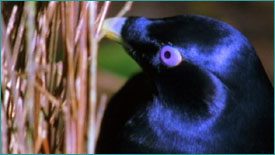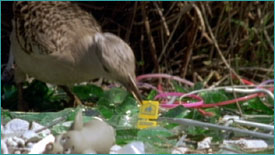 |
 |
|
|  Gerald Borgia framed by the walls of a
bower.
Gerald Borgia framed by the walls of a
bower.
|
On the Trail of the Bowerbird
Charles Darwin scratched his head over the purpose of bowers, the carefully
tended sex dens of the bowerbird. But few scientists had conducted studies of
these ornate constructions and their earnest builders until Dr. Gerald Borgia,
a biologist at the University of Maryland, College Park, put aside dung flies—the subject of his doctoral dissertation—and began studying bowerbirds in
1980. In this interview, find out why seeing his first bowerbird copulation was
a high point of Borgia's career, how male bowerbirds were so taken with robotic
female bowerbirds used in one study that they tried to mate with them, and
other tales from two decades in the field.
NOVA: Why do male bowerbirds go to the trouble to build such elaborate bowers?
What's in it for them?
Borgia: Well, I think there are a lot of reasons. I think in some cases the
bower functions as an attracting device to females. But it also has an
important role in modulating a male's display so the females can observe it
from a comfortable position. It also provides a stage for the performance of
the male and helps orient the female. Once she's inside the bower it orients
her in a way so as to maximize the appeal of the display he's giving. So it
seems the bowers have taken on multiple functions.
NOVA: After he mates with the female will he reuse the bower? Or will he build
a whole new bower in order to attract the next female?
Borgia: He reuses the bower. Male satin bowerbirds, we know, may mate with 25
different females. One male in one year had 53 copulations. So the bowers are
used quite a lot.
 Stud of studs: A single male satin
bowerbird may mate with more than 25 different females.
Stud of studs: A single male satin
bowerbird may mate with more than 25 different females.
|
|
NOVA: Do bowerbirds learn to build bowers by watching other bowerbirds or are
the skills innate?
Borgia: That's a good question. I suspect it is a combination of things. We've
got some evidence from naïve bowerbirds raised in captivity that they can
put sticks into the ground, so that part at least seems to be innate. What we
know also is that as males age their bowers improve.
I just did an experiment in which I offered straw, or I should say grass, to
males who were building stick kinds of bowers. Usually males who use grass,
such as spotted bowerbirds, use it to line the avenues of the bowers. In this
case when these males who normally didn't use grass in any part of their bowers
were offered grass, they put it all over the bower as if they didn't know what
to do with it. And in some cases when I came back a week later they had gotten
it so that so that the grass was actually lining the walls of the bower. So
what it looks like to me is that it sometimes takes some time to sort it all
out and make modifications to their bowers. That seems to be a kind of
learning.
|  This Western bowerbird has a weakness
for sea glass and plastic toys.
This Western bowerbird has a weakness
for sea glass and plastic toys.
|
NOVA: How similar are bowers built by members of the same species? Do they look
essentially alike or is there room for personal style?
Borgia: This is very interesting. In satin bowerbirds there is variation, but
usually among mature males the bowers aren't very different, certainly within a
specific population. Though what I just found with the spotted bowerbirds is
that a lot of variation exists within a population in the width of the bower,
the way the decorations are displayed, whether it has two walls or three walls,
and whether it uses straw and sticks or just sticks.
NOVA: Have you seen corresponding success rates in attracting females among
males who have, say, wider bowers?
Borgia: We haven't usually been able to associate physical dimensions of bowers
with mating success in satin bowerbirds. Certain aspects of the bowers do seem
to be important. For example, having a neatly built bower and having both use
of fine sticks and high densities of fine sticks all seem to be associated with
mating success in satin bowerbirds. Among spotted bowerbirds, the males who use
finer straw tend to mate more.
 The best-dressed
bowers get all the girls.
The best-dressed
bowers get all the girls.
|
|
NOVA: Have you tracked a single male who year after year has failed to copulate
with a female? If so, what was the poor fellow lacking?
Borgia: We have males like that but we haven't really sat down and focused on
them in our analysis; we're usually more interested in when they are
successful. Usually, though, the ones that fail are lacking in a lot of things.
Their bowers aren't good: They aren't neatly built, and they don't have a lot
of bower decorations. I suspect that they are kind of progressively inferior or
weak; maybe they have more parasites. Usually we see a whole group of
characteristics that all correlate with the success of the males. It may come from the
fact that these males tend to be more aggressive and dominant
too. Healthy males do everything well.
NOVA: How many bowers does a female visit before settling on a mate?
Borgia: In satin bowerbirds, a female will visit three to four bowers before
settling on a mate. Now, that figure varies with the past experience of the
female. If the female mated with a very good male the previous year she will
often go directly back to him the next time and not do mate searching.
Continue: Robotic female bowerbirds
Photo credits
On the Trail of the Bowerbird |
Are Bowers Art? |
Creature Courtship
Bowerbird Matching Game |
Resources |
Teacher's Guide
Transcript |
Site Map |
Flying Casanovas Home
Search |
Site Map |
Previously Featured |
Schedule |
Feedback |
Teachers |
Shop
Join Us/E-Mail |
About NOVA |
Editor's Picks |
Watch NOVAs online |
To print
PBS Online |
NOVA Online |
WGBH
© | Updated December 2001
|
|
|
|